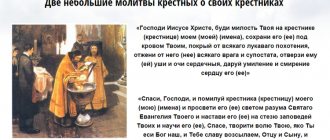The sacrament of child baptism is mandatory for Orthodox Christians. They try to baptize children at an early age, this means that a person is accepted into the ranks of the church and after death can be accepted into the Kingdom of Heaven. Most parents choose 40 days from birth for baptism. This is due not only to a number of church rules, but also to the fact that in the first 2 months of life, a baby can tolerate immersion with his head under water much easier, since he retains the natural instinct of holding his breath.
The essence of the Baptism of children in the church
A sacrament is a sacred action through which the grace of the Holy Spirit is invisibly given to a person. The baptism of a child is the most necessary of the seven Sacraments of the church. It serves as a door to the Church of Christ: a person who has accepted Baptism becomes a member of the Church, is born for a new, Christian life, and therefore baptism is also called “spiritual birth.” The Lord Himself said: “Unless someone is born of water and the Spirit, he cannot enter the Kingdom of God,” that is, he cannot become a member of the Church and participate in other Christian sacred rites.
When is the best time to baptize a child?
There is a church tradition to baptize a child on the 40th day of birth. But this is optional. You can choose any date for the Sacrament of Baptism, you just need to consider the following:
– on the days of the Great Holidays , due to long services, children may not be baptized,
– the godmother will not be able to fully participate in the ritual during her period,
- the most important
come to the church for a service or at another time, talk with the priest and find out on what days Baptism is performed and preparatory conversations take place.
Who to choose as godparents
Traditionally, if a child has one godfather, a person of the same sex as the baby is chosen. If 2 godparents are planned, then this is a man and a woman. In this case, the baby has godparents (spiritual) father and mother.
Choosing the right person is especially important. A person is needed who is close to the family and ready, if necessary, to take care of the child. Thus, in most cases these are close friends of the parents or relatives. It is not advisable for godparents to be very old, as this may not allow them to fully fulfill their duties.
It is good if a deeply religious person is chosen as a godparent who can guide the child in the spiritual world. It is not forbidden to make grandparents, aunts or uncles godparents.
There are categories of persons who cannot participate in the sacrament of baptism and become godparents for a child.
These include:
- persons under 15 years of age;
- people of other religions;
- atheists;
- mentally ill persons;
- drug addicts;
- alcoholics;
- persons leading a depraved lifestyle;
- parents of the baby;
- nuns;
- monks;
- brothers;
- sisters.
Twins are baptized on different days, but the same people are allowed to be their godparents.
How does the Sacrament of Baptism occur?
At the very beginning, the catechumen or godparents (if a child will be baptized) stand next to the priest, who reads prayers for the enlightenment of the person about to be baptized and for his preservation from evil. Then he turns them to face the west and invites them to renounce the devil and all his evil deeds. After this, you need to blow and spit on the devil. This gesture symbolizes hatred of evil deeds and sins.
Then the man, together with the priest, turns to face the east and pronounces words of faith in Christ. The priest asks the catechumen three times whether he has renounced Satan and his evil deeds. This question must be answered positively three times. Then the priest asks whether the person believes in Christ and is united with Him. This must also be answered positively three times.
After this, the catechumen or godfather reads the Creed . Then the priest reads a prayer for the blessing of water. He blesses the water with his hand, singing “Hallelujah” three times, then drops the blessed oil into it. The priest will anoint the person being baptized with this oil.
Main part of the Sacrament
Then the main part begins - immersing a person three times in the font with the words: “The servant (servant) of God (name) is baptized in the name of the Father. Amen. And the Son. Amen. And the Holy Spirit. Amen".
Having taken the child out of the font, the priest gives him to his godparents, who hold a towel at the ready. They dry him and put a baptismal robe on him. At this time, the priest reads a special prayer for the consecration of baptismal clothing.
a cross is placed around the person’s neck , which he must not remove until his death. Next comes the Sacrament of Confirmation. After this, the godfather with the godson in his arms (or the person being baptized himself) follows the priest around the font, singing “As you were baptized into Christ, you put on Christ” (Gal. 3-27). This procession is repeated three times as a sign that a person is ready to follow Christ through life and imitate Him in earthly life.
Then an excerpt from the Apostle and the Gospel are read. Then litanies follow, and then the hair of the person being baptized is cut as a sign of the dedication of soul and body to God. The cut hair is wrapped around a candle by the priest and lowered into the font. (On this score, there are popular beliefs about how a candle will behave in a font, whether it will sink or not. This, of course, is a prejudice and has nothing to do with faith).
The rite of churching of the newly baptized
After this, the rite of churching the newly baptized begins. A special prayer is read, males are brought into the altar with bows, and women are brought to the pulpit. Then the priest usually reads a prayer to the mother of the baptized child for cleansing after childbirth.
In the near future after the Sacrament of baptism, the baby should be brought to the temple to receive the Holy Mysteries.
Sacrament of Confirmation
After this, the Sacrament of Confirmation is performed. You will be anointed with holy oil again, but this time it is not oil, but holy Chrism. In this Sacrament, a person is given the gracious Gifts of the Holy Spirit for leading a Christian life. And this Sacrament is so important that it, like baptism, is accepted by a person only once (the second time in life they are anointed only upon ordination as a bishop and upon accession to the royal throne, hence the expression “anointed to the kingdom”). The priest will anoint the forehead, chest, lips, eyes, nose, ears, hands and feet.
Holy Chrism (from the Greek μύρον “fragrant oil”) is a specially prepared and blessed fragrant oil. In the Orthodox Church, Miro is prepared on the basis of olive oil with the addition of white wine and many aromatic substances (this includes aloe, incense, rose petals, violet, spicy and galangal roots, nutmeg, rose, lemon and clove oil - about forty ingredients in total). The abundance of components symbolizes the diversity of Christian virtues.
The myrrh is brewed by the Patriarch on Holy Week in the Small Cathedral of the Donskoy Monastery (in Moscow), where a special oven has been built for this purpose. It is consecrated on Maundy Thursday (the last Thursday before Easter) in the Patriarchal Epiphany Cathedral in Yelokhov, and from there it is transported by bishops to their dioceses. This is where the saying in Russian comes from: “everyone is smeared with the same brush.”
Previously, baptism was performed quite rarely in churches, because they were waiting for the graduation from the catechetical school and a general parish celebration was held. And they celebrated in the following way: they made a small religious procession to some famous place that was located not far from the temple, or they walked around the temple itself and sang songs of the newly baptized, in which they glorified the event that had taken place. And so, you will also be invited to take part in the procession of the cross, which, as a rule, now takes place around the font where the baptism took place. To do this, you will need candles prepared in advance, one for each person. During the religious procession, you will also be invited to take part in general singing, and this opportunity should not be missed. Especially if everything is recorded on a video camera.
Next, the Holy Scripture is read, and the priest prays for the godparents and those being baptized.
Immediately after Baptism and Confirmation, a person makes the first, at least in his baptized life, grateful sacrifice to God. And such a sacrifice is none other than his own hair, that adornment that crowns the most wonderful part of our body. Your hair will not suffer; the priest will cut your hair three times very modestly and tastefully, in the form of a cross on your head.
Baptism ends with prayers of churching, while men are led into the altar - the holiest place of the Temple, and they are read to women in front of the icon of the Most Holy Theotokos.
How to prepare for the Sacrament of Baptism: rules
An adult about to be baptized (or godparents) must know the basics of the Orthodox faith. For this purpose, special conversations are held on the eve of baptism. Also, a person must be able to read the Creed by heart (I Believe in One...)
You must have with you to the Sacrament of Baptism:
- pectoral cross,
- white baptismal shirt (this color symbolizes Divine Grace and purity of the soul),
- large towel.
It is usually customary for godparents to give an icon of the saint.
The name of the catechumen must correspond to the calendar, no “Angels”, “Alberts”, etc. there shouldn't be. Sometimes the baby is given the name of a saint, who is celebrated on his birthday.
You cannot approach the Sacrament of Baptism:
- while intoxicated;
- in carnal uncleanness;
- for women – with bright makeup;
- in unbelief (simply because everyone is baptized, and I need to).
Godparents must be:
- Orthodox believers;
- sober;
- in carnal purity.
The choice of godparents must be approached with all seriousness; they must be believers, reliable people, and not the first people they meet.
Professor A.I. Osipov about the Sacrament of Baptism
How to choose a temple for child baptism
The temple for performing the sacrament of baptism can be any Orthodox church of the Russian Orthodox Church of the Moscow Patriarchate or another canonical Local Orthodox Church, either located directly next to the family’s place of residence, or chosen at will.
Using the service - map of churches - on our website you can choose a temple for the baptism of a child, it can be the temple closest to your home. Here you can also find out about the location of other churches in your locality.
How to choose an Orthodox name for a child
Most often, we find out with what name we will baptize a child only before the Sacrament of Baptism. But you can make such a choice in advance and coordinate it with the priest.
According to ancient church regulations, the child was given a name in honor of the saint, whose memory falls on the eighth day from birth. This is what is called naming a name according to the calendar. But now parents look at the euphony of the name, and at the fame and degree of veneration of the saint, whose memory is celebrated on the day or shortly after the birth of the baby. This is a modern practice, as many Orthodox parents do. No one can also forbid you to name your child in honor of some saint, especially revered in your family, even if his memory does not coincide with the date of birth.
Participle
The baptized person is allowed to take communion immediately. Further, the date of his first communion depends only on when his parents bring him. More often than not, parents take their child to communion for the first time when he can already understand what is happening, and this is 4-5 years old. At the same time, there is no prohibition on an infant who was baptized even the day before taking part in the sacrament of communion. Communion after the baptism of a child can be held from the next day.
If the child is under 3 years old, then he must be fed for the last time 2 hours before communion. Children over 3 years old must refuse food on the day of communion before it.
During communion, a pectoral cross must be worn. You should not take part in the sacrament of communion without a cross.
Age
Ideally, a child should be baptized in the first days of life. You can, following the example of the Christ child, baptize him on the eighth day after birth. True, then the Sacrament will take place without the mother of the newborn: she can enter the temple only after a cleansing prayer, and this happens forty days after birth. Infancy in Orthodoxy lasts up to seven years. It is believed that such children are not yet capable of taking responsibility for their actions, so they can receive communion without confession.
“But they are not free from original sin - the inheritance of the act of Adam and Eve,” explains the press secretary of the Syktyvkar and Komi-Zyryan diocese, Archimandrite Philip (Filippov) . – Before baptism, babies are deprived of many opportunities: they cannot receive communion, celebrate Angel Day, which they simply do not have yet, they cannot pray for them in the Church - only at home. In any case, the choice of the timing of Baptism remains with the parents. It is for parents, and not for grandparents and other relatives, friends and sympathizers.
When to baptize a child
At what age can a child be baptized? Traditionally, a baby is baptized on the 40th day after birth or later. This is due to the fact that a woman is not allowed to enter the temple in the first weeks after giving birth, as she is considered “unclean.”
An earlier baptism is also possible, for example, on the eighth day after the birth of a child, but when the ceremony is performed in a temple, the mother will not be able to attend it.
How to choose a child's name at baptism
In fact, the name is chosen even before baptism, in accordance with the names of those saints whose name appears in the church calendar on your baby’s birthday.
True, it happens that such names do not quite correspond to the modern situation; for example, few parents would agree to name their son Afinogenes or Theopent.
Then choose the name that you like, but when baptizing, still be guided by the church calendar, if the named one does not apply to the Orthodox (for example, Timur - Timothy).
There is a belief that it is necessary to specifically baptize and call a child by different names according to the passport, they say, this will help protect the child from the evil eye.
But this belief has nothing to do with the Orthodox world and came to us from Jewish traditions or Islam. It is impossible to rebaptize a child into a different name if, for example, he gets sick.
Godfather and godmother
The godparents of a newly converted Christian actually become his second parents. Now responsibility for the spiritual and moral life of their child before God lies with both biological and spiritual fathers and mothers. Therefore, the choice of godparents should be approached seriously. It is better not to “appoint” frivolous people, even if they are childhood friends and just sociable guys.
Also, you should not agree to a flattering offer to become a godfather or godmother if sleep on a Sunday morning is more valuable to you than the communion of your little ward and in general you are still far from church. When becoming a godfather or godmother to a charming baby, you must not forget that very soon he will become a rebellious teenager, and it is you, in alliance with your parents, who will have to protect him from worldly temptations.
– Godparents bear full responsibility for the godson until he turns 18 years old. Then, as a Christian, he is responsible for himself before God. Orthodox upbringing and education is the work of godparents, and it is good when this happens in conjunction with biological parents. This care includes home education, attendance at liturgies, and other spiritual duties, explains Archimandrite Philip .
During the baptism itself, it is the godparents who loudly renounce Satan for the baby and unite with Christ and receive their child from the hands of the priest from the font. During the sacrament, godparents often hold the child in their arms - unless, of course, he himself does not object. If it was not possible to find both godparents at once, then the boy needs a mentor-godfather, and the girl needs a mentor-godmother. By the way, godfather and godmother cannot be husband and wife.
Gifts for a child
In the old days there was a traditional church gift for christening - a silver spoon called a “tooth gift”, it was the first spoon when feeding a child.
Nowadays, gifts for Epiphany have become more diverse. For example, the KrasaDivo store offers gift sets for the Baptism of a boy and a girl, including:
- Valdai bell (Orthodox),
- baby spoon (with engraving)
- storage bottle (hair, tag, first tooth, etc.)
- guardian angel
- designer packaging
Godparents rules for preparing for the ceremony
The godmother and father, participating in the Baptism of the child, take responsibility for the little member of the church, therefore they must be Orthodox people. So, everything in order.
When choosing godparents you should remember:
– according to the tradition of the Russian Orthodox Church, a husband and wife (married couple) cannot be godparents of one child,
- monastics, clergy, people of other faiths and persons under the age of majority also cannot be godparents.
Who can be godfather:
– believing relatives such as aunts or uncles, cousins and brothers.
– a boy can be baptized by one godfather, and a girl by one godmother. – a pregnant woman can be a godmother.
When choosing godparents, the main thing is whether this person will subsequently be able to help you in the good, Christian upbringing of your child.
Preparatory conversations before Baptism
The purpose of the clarification (preparatory) conversations is the opportunity to show both the beauty of the Orthodox faith and the depth of the Sacrament of Baptism. Father’s task is for you to see the true meaning of Baptism for our lives. We were able to experience the solemnity of this Sacrament in a new way, so that those words that will then be heard in the temple were more understandable for you, and the sacred rites themselves acquired a deeper meaning.
Typically, such conversations take place in 1-2 meetings. If you (godfather or godmother) are in another city, then in any church convenient for you, attend a public conversation with the Father, having previously told about the upcoming Sacrament.
How to prepare for a child's baptism
One must prepare not only morally for the baptism of a child, although this, of course, is the most important condition. You will need baptismal “accessories,” and in some churches you will have to attend special conversations on the topic of baptism.
What will you need? First, the cross. It doesn’t matter what it will be held on the neck: on a simple braid or a gold chain. Secondly, a baptismal shirt - you can buy it or sew it yourself. In fact, as Fr. Philip, this is not a mandatory attribute of baptism, it’s just accepted in church tradition. A clean, light-colored vest or dress will be enough. Thirdly, candles. They can be purchased before the Sacrament is performed in the temple where it will take place. They will be needed to participate in the procession during the sacrament. Fourthly, the towel is not a small waffle one, but a large bath towel.
It’s also worth thinking about what to dress your baby in. It is better to avoid sliders. A sandbox or “legless” pants are ideal: there are moments in the sacrament when the baby’s legs should be exposed.
Public conversation
Both the parents and godparents of the future Christian must be present at the public conversation. They will tell you about the essence of baptism, God, the history of the creation of the world, the Fall and the history of mankind before the Incarnation - the coming of Jesus Christ into the world. The godparents are informed that from now on they have a great responsibility for the moral education of the future godson.
There must be at least two public conversations.
Prayer before baptism
Godparents should know before performing the sacrament of prayer:
King of heaven
Heavenly King, Comforter, Soul of truth, Who is everywhere and fulfills everything, Treasure of good things and giver of life, come and dwell in us, and cleanse us from all filth, and save us, O Good One, our soul.
Virgin Mary, rejoice
Virgin Mary, Hail Mary of Grace, the Lord is with You, Blessed are You among women and blessed is the fruit of Your womb, for You have given birth to the Savior of our souls.
Our Father
Our Father, who art in heaven! Hallowed be Thy name, Thy kingdom come, Thy will be done, as it is in heaven and on earth. Give us this day our daily bread, and forgive us our debts, as we forgive our debtors; and do not lead us into temptation, but deliver us from the evil one.
You need to be able to read the Creed (it’s better to know it by heart), the text of this prayer will definitely be given to you:
Symbol of faith
I believe in one God the Father, Almighty, Creator of heaven and earth, visible to all and invisible. And in one Lord Jesus Christ, the Son of God, the only begotten, who was born of the Father before all ages; Light from Light, true God from true God, born, uncreated, consubstantial with the Father, to Whom all things were. For our sake, man and our salvation came down from heaven and became incarnate from the Holy Spirit and the Virgin Mary, and became human. She was crucified for us under Pontius Pilate, and suffered and was buried. And he rose again on the third day according to the Scriptures. And ascended into heaven, and sits at the right hand of the Father. And again the coming one will be judged with glory by the living and the dead, His Kingdom will have no end. And in the Holy Spirit, the Lord, the Life-Giving One, who proceeds from the Father, who with the Father and the Son is worshiped and glorified, who spoke the prophets. Into one Holy, Catholic and Apostolic Church. I confess one baptism for the remission of sins. I hope for the resurrection of the dead and the life of the next century. Amen.
Godparents read prayers during the baptism ceremony of a child
Preparation for the ceremony
Preparation for the baptism of a child is required from persons who are chosen as godparents. A few days before the sacrament, they must observe strict fasting, during which a complete renunciation of any entertainment and sexual contacts is also required. Also, before the ceremony, they receive communion after first confessing.
It will be good if the parents also confess and cleanse themselves before the sacrament. When it is best to do this is determined with the priest.
The godfather must also learn the prayer read at the baptism of a child - the “Symbol of Faith.” It is read 3 times during the sacrament. The godfather may also be required to read it over the baby by heart.
How is a child baptized?
Baptism can be private or collective. Especially many baptized people gather in the church on the feast of Epiphany on January 19. But for the child’s family, this is one of the most important events in life, therefore, as a rule, the day of the child’s baptism is agreed upon in advance, and it takes place intimately - only for this little Christian.
Before the sacrament begins, the priest will explain to everyone his role and place in the temple: godparents or parents with the culprit of the event in their arms, grandmothers, sisters-brothers and other relatives. Baptism begins with naming prayers, with which those being baptized are assigned their Christian names.
From this moment on, the baby acquires a heavenly patron and protector in the form of a Guardian Angel. If the calendar does not contain the name that the baby was given at birth, he receives a new one - a church name. So, Elvira can become Emilia, Yana - Ioanna, Adele - Aglaya.
Then comes the time of exorcism. The method of expulsion is reading four prohibitory prayers. In them, the evil one is forbidden to deal with a newly converted Christian. As a sign of this, the priest turns to those being baptized and blows three times in the shape of a cross into each person’s face, pronouncing the corresponding words of the spell.
Now the participants in the sacrament turn to face the west - as a rule, this is the exit from the temple, and the priest begins to ask questions, which should be answered loudly, clearly and preferably in unison. The priest asks twice and three times whether those who came renounce Satan, to which they, of course, answer in the affirmative: “I renounce.”
In addition to verbal renunciation of the evil one, participants in the sacrament confirm this with action. After the priest says: “Blow and spit on it,” they do it literally. Insulting the demon, the Orthodox Christian seems to categorically declare: I have nothing in common with you, Satan, I spit on you and will do so all my life.
Having renounced Satan, the Orthodox unites with Christ. To do this, everyone returns to their original position facing east: with their backs to the entrance, and facing the altar, and again answer the priest’s questions. Several times, with the help of questions, he clarifies the conscious intentions of the parents and godparents of the child, who again respond with prepared formulations. If someone has forgotten them after the public conversation, the priest will tell you. Now it’s the godparents’ turn. One of them will have to read the main testament of a Christian - the Symbol of the Orthodox Faith. And preferably by heart.
– A creed is a set of basic religious truths or dogmas, which briefly states what we, Christians, believe. If none of those who come know the Creed by heart, the priest himself can read it, and the rest will try to understand at least something. Ideally, every Christian should not only know it by heart, but also be able to comment on each line. This is usually the first task in Christian self-education. It is easy to find the Creed, it is in any Prayer Book or in a book that is simply necessary for everyone and which has a very familiar name: “The Law of God,” explains Archimandrite Philip.
After reading the Creed, the priest reminds baptism participants how to properly make the sign of the cross and bow.
– When making the sign of the cross, the fingers must be folded in a certain way, “pinch”: the thumb, index and middle fingers together, which means our faith in the Trinity, the ring and little fingers are pressed to the palm - as a sign that Christ was both God and Man. We overshadow ourselves with them like this: on the forehead, on the stomach, on the right shoulder and on the left, then a small bow. It is as if we invoke God’s sanctification on all our thoughts, feelings and actions. And we are baptized from right to left in honor of the prudent thief, who was crucified at the right hand of Christ and did not swear at Him along with everyone else, but simply quietly asked that the Lord remember him in the Kingdom of Heaven,” explains the priest.
Now comes the most important part. Baptism is impossible without water, since Christ himself was baptized in the waters of the Jordan River. That is why on Epiphany, despite any frost, Russians rush to the fonts and ice holes. The priest sanctifies the water for a child’s baptism either directly during the sacrament, or, usually, in advance. Don't worry that the baby will freeze: the water for baby baptism is always warm. Before immersion, the priest will anoint the baby with oil, which symbolizes the Grace of God - forehead, chest, ears, arms and legs. After this, the child is immersed in water three times. Some kids are scared, but others, on the contrary, like it. The baby's reaction during baptism will be the subject of conversation and memories for many years to come.
Ideally, a child should be baptized in the first days of life. Photo: Andrey KARA Now the baby is rightfully considered Orthodox, and a cross is put on him. It is no coincidence that the cross is called a body cross; it is not worn on top of clothing as an ornament, it should literally be on the body.
The sacrament of child baptism can be called double, because in its process one more thing is performed. Like baptism, it occurs only once in a person’s life. This is the sacrament of Confirmation. “In this Sacrament, a person is given the grace-filled Gifts of the Holy Spirit for leading a Christian life,” comments Fr. Philip. “They are anointed for the second time in their lives only when they are ordained as bishops, and before, when they ascend to the royal throne, hence the expression “anointed to the kingdom.” Just like with oil, the priest will anoint the child’s forehead, chest, lips, eyes, nose, ears, hands and feet. After all this, the time comes for a procession of the cross - a very small one - around the font where the baptism took place. This is where the candles prepared in advance are lit. Usually at this time everyone is in high spirits, many willingly respond to the priest’s call to sing along with the singers. Afterwards the Holy Scripture is read, and the priest prays for the godparents and their godson or goddaughter. Immediately after Baptism and Confirmation, the priest carefully cuts off a small strand of hair with small scissors. This is the first grateful sacrifice of a newly converted Christian to the Creator. The baby's baptism is almost over. All that remains is to read the prayers of churching, and for boys this is done in the most sacred place of the temple - the altar. Girls, like women, are not allowed to go there, so prayers are read to them in front of the icon of the Most Holy Theotokos. This is interesting. Is it possible to baptize a child during Lent before Easter? When deciding to baptize a child during Lent, on Easter, that is, on Holy Week, one must remember about food restrictions and the strict attitude of this period of church life
About public conversations, or why are lectures needed before baptism?
Today, in most churches in Yekaterinburg, as part of preparation for the Sacrament of Baptism, attendance at special classes is offered - catechetical conversations. The quantity and quality of them in each church is different, but the meaning is the same - to explain to those being baptized the foundations of the faith that they are going to accept, to talk about the changes that occur in life after baptism. That is, public conversations should promote a more conscious and more serious approach to Baptism.
The catechumen - that is, oral instruction in faith before receiving baptism - this is exactly the new that is well forgotten old. The tradition of catechetical conversations was formed in the Church already in the second and third centuries after the Nativity of Christ. Then the announcement lasted from forty days to three years. Even special catechetical schools were created, which truly became centers of education. For example, in one of the most famous - the Alexandrian Catechetical School - not only theology and philosophy were taught, but also ethics, dialectics and even physics.
The memory of the traditions of the ancient Church has reached us in worship and folklore. Until now, the main church service - the Liturgy (the same one that you can attend if you come to church on Sunday morning) is divided into two parts. The first part is called the “liturgy of the catechumens” - it is attended by the unbaptized, but preparing for baptism, that is, the catechumens. They pray together with everyone, listen to the reading of the Holy Scriptures and the sermon. This part ends with a special prayer - specifically about the catechumens. There are words addressed by the priest to themselves: “Pray, the catechumens, to the Lord,” after which the catechumens themselves must answer, “Lord, have mercy.” And since there were many catechumens in the ancient Church, and they responded with enthusiasm, the saying arose “cry like catechumens.” However, today it is not relevant, since all prayers are sung by the church choir. The second part of the service - the “Liturgy of the Faithful” - begins with the words “Catechumens, come forth.” During the second part of the liturgy, only the baptized remain.
Now in many churches this catechetical conversation is partially restored, although in very different forms. Somewhere, godparents or adults being baptized are required to attend only one conversation prior to the performance of the Sacrament. And in some places you need to attend 12 or 16 classes. Public conversations make it possible to obtain information, as they say, first-hand, and in some way are a unique opportunity for a kind of church educational program.
In any case, you will have to clarify whether the temple you have chosen for baptism has such conditions for its acceptance, and whether you are ready to agree to it. There is always one more proven and traditionally Russian way to solve all problems - to be baptized by acquaintance. Then, as a rule, the familiar priest hopes for your home self-education, and will not torment you with tedious narratives, if this is how you evaluate everything that happened from the creation of the world until the events of at least 33 years from the Nativity of Christ in Palestine.
Baptism: what you need to know
The sacrament of baptism is the beginning of the life of a Christian. Preparation for this event should be as serious and meaningful as possible, both on the part of the person receiving baptism and on the part of his godparents and close people. We collected the most important questions from readers about the sacrament of a person’s entry into the Christian tradition and asked them to Archpriest Alexy Mityushin, rector of the Church of the Life-Giving Trinity in Kozhukhovo.
What do godfathers and godmothers need to know?
First of all, the godfather and godmother need to know the faith of Christ and, moreover, live by this faith. Because our faith is not so much in our words as in our deeds, in our very lives. If godparents do not live by faith, how can they reveal faith to their godson? In modern church practice, in most cases, godparents only have the opportunity to pray for their godchildren, and their parents raise them.
Therefore, parents, like godparents, must be Christians in the full sense of the word. Before baptizing your children, you need to decide whether we are really Christians or whether we are on our own, we have our own “faith”, our own views on faith. If a person still has any doubts and stereotypes about faith and the Church, it is better to take a break and understand ourselves. Otherwise, you can deceive your children, your godchildren - baptize them, but not give them faith. This would be a profanation of the sacrament.
What is the difference between the baptism of a boy and a girl?
The baptism of a boy and a girl has only one difference. The godmother is the main recipient of the girl from the font. And the main godfather for the boy is the godfather, so he receives the baby after immersion in the font.
What to buy for a child's christening
Baptism supplies you will need;
– Kryzhma (white cloth, towel) to wrap the child after the bath
– White baptismal shirt and for the girl a headdress (kerchief) made of chintz, cotton,
– Pectoral cross , the only thing you need to take into account is that for small children it is preferable to have a cord with a clasp, it is more pleasant to the body than a chain.
christening scarves for godmother and mother
Catalog of scarves with prices
Lace stole for temple
Cape for church
Celebration of christening
Typically, after the baptism ceremony is completed, the family invites guests to celebrate the occasion. At the same time, there is a rule that payment for the ceremony, as well as the purchase of products for the festive table, should fall on the shoulders of the godfather. It is customary to bring gifts to the baby at christenings. This is done by both godparents and all other guests.
What can you give a child for christening? Gifts can be different, there are practically no restrictions. For your child, you can choose a beautiful and useful thing of your choice that will benefit him. This could be a silver spoon or mug, an educational toy, a beautiful outfit, a photo album, money, or jewelry made of precious metals. It all depends on the preferences and financial situation of the guests.
What is the meaning of baptism? With its help, a person becomes closer to God; this ritual symbolizes spiritual birth, connection with the Lord. Therefore, this ritual should be performed as early as possible. If parents do not know something or have any difficulties with it, they should contact a priest. You should not ask friends and relatives for advice on this issue.
The difference between the baptism of a boy and a girl
The main difference between the baptism of a boy and a girl is that a male child is brought into the altar after immersion and confirmation, while a female child is not. According to Orthodox tradition, only men can be in the altar of the temple. The difference also lies in the correspondence of the gender of the godfather to the child being baptized.
A boy is brought into the altar during the baptism ceremony











